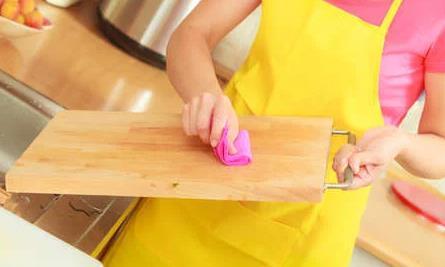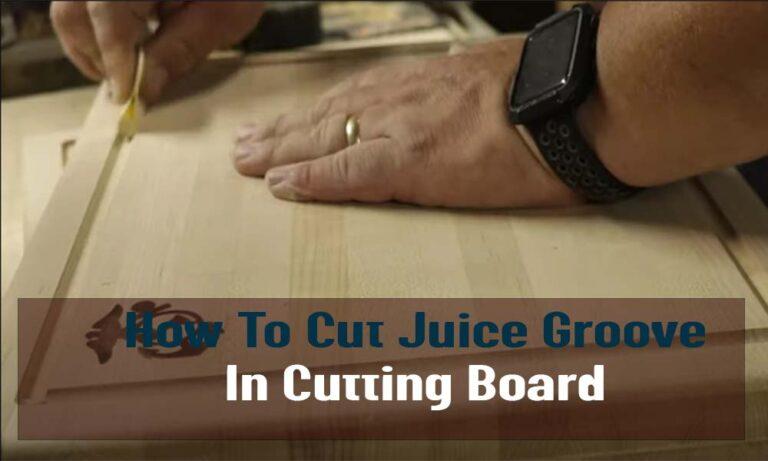How To Clean Wooden Cutting Board With Vinegar? 5 Easy Steps

If you cook at home, you probably have a wooden cutting board. Not only do wooden cutting boards look nice, but they are also strong and can last for years. But, like any other cutting board, keeping them clean is essential to stop the spread of bacteria that can make people sick. Using vinegar is one of the best and most natural ways to clean a wooden cutting board. But how to clean wooden cutting board with vinegar.

Vinegar is a natural cleaner that can be used in many ways and doesn’t cost much. It can clean and deodorize your cutting board well. In this article, we’ll look at the cleaning steps of a Wooden cutting board with vinegar and give you simple, easy-to-follow instructions to keep your cutting board clean and safe. So, whether you’re an experienced chef or just starting, you must know how you clean your wooden cutting board with vinegar. This will keep your kitchen clean and healthy.
Process of How To Clean Wooden Cutting Board With Vinegar
Cleaning a wooden cutting board with vinegar is an easy and effective way to sanitize and remove any bacteria or odors. Here are the steps to follow:
1. Gather Supplies
To clean your wooden cutting board, first, gather supplies. You will need white vinegar, baking soda, a spray bottle, a scrub brush or non-scratch sponge, and a clean cloth. Make sure that all of these items are clean and ready for use.
2. Prepare Vinegar Solution
Start by preparing the vinegar solution. Mix 2 tablespoons of white vinegar with a quart of warm water. You can also use apple cider vinegar if the concentration is similar. For a more robust solution, you can increase the amount of vinegar.
3. Scrub the Cutting Board
Take a brush with stiff bristles and scrub the wooden cutting board with it. If the board is heavily stained, paste baking soda and vinegar, and rub it into the stains. Use a circular motion to clean the board and cover the entire surface.
4. Rinse the Cutting Board
After scrubbing the wooden cutting board with vinegar, rinse it off with warm water. You may use a clean cloth or a soft-bristled brush for this step.
5. Dry the Cutting Board
After rinsing the cutting board with hot water, it is essential to dry it with a clean cloth. Ensure that the cloth is non-abrasive and does not contain any chemicals. Wipe away all the remaining vinegar and water to avoid damaging the board. Allow the cutting board to dry completely before using it.

Note: While vinegar effectively kills most bacteria, it may not be enough to kill all harmful bacteria or viruses. To ensure that your cutting board is thoroughly sanitized, use a specialized cleaner or a solution of bleach and water. Additionally, always wash your cutting board after each use and avoid cross-contamination by using separate cutting boards for different foods.
Is Cleaning Vinegar Safe For Wood?
Cleaning vinegar, or “distilled vinegar,” can be used on wood surfaces without harm. But it’s important to remember that vinegar is an acid, and if you use it too much or too often, it could damage the surface of the wood.
If you want to clean wood with vinegar, diluting it with water first is best. One part vinegar to ten parts water is a good rule of thumb. First, test the diluted solution on a small, hidden part of the wood to ensure it doesn’t damage or change the color of the wood. It’s also important not to use too much water when putting vinegar on wood. When wood gets too much water, it can swell or warp, which can cause damage over time. Use a damp cloth instead of one dripping wet, and always dry the wood well after cleaning it.
Ultimately, cleaning vinegar can be used on wood if it is diluted and only a tiny amount is used at a time. It’s always a good idea to test any cleaning product on a small, hidden part of the wood first and dry it well afterward to avoid damage.
What Is The Advantage Of Vinegar In Cleaning Cutting Boards?
There are a few good reasons to clean a cutting board with vinegar:
Antibacterial properties:
Vinegar can kill germs and bacteria on your cutting board because it is a natural disinfectant with antibacterial properties. This is very important when cutting raw meat, which can have bacteria that can make you sick.
Safe and non-toxic:
Vinegar is a safe and non-toxic way to clean cutting boards, so you don’t have to worry about harmful chemicals getting on your food.
Cost-effective:
Vinegar is cheap and can be found in most homes. That makes it an excellent alternative to more expensive commercial cleaning products.
Effective for removing stains and smells:
Vinegar can help remove stains and smells on your cutting board, leaving it clean and fresh. That is especially helpful after cutting smelly foods like garlic or onions.
Easy to use:
Vinegar makes it easy to clean your cutting board. Mix equal parts of water and vinegar in a spray bottle, spray the solution on the cutting board and wipe it clean with a damp cloth or sponge.
What Is The Disadvantage Of Vinegar In Cleaning Cutting Boards?

- Vinegar is acidic, damaging the cutting board‘s surface over time, especially if used frequently.
- It may not effectively remove tough stains or odors from the cutting board.
- Vinegar has a strong smell that can be difficult to remove even after rinsing the board.
- Using vinegar on a wooden cutting board can cause the wood to dry out, leading to cracks and splits.
People Also Ask
Why do you clean a wooden cutting board with vinegar?
Vinegar is a natural disinfectant that can kill bacteria and other harmful microorganisms that may be on a wooden cutting board.
What kind of vinegar should I use for cleaning the cutting board?
Most of the time, white distilled vinegar is used to clean wooden cutting boards. You can also use apple cider vinegar, which might leave a smell on the board.
How do I use vinegar to clean a wooden cutting board?
Fill a spray bottle with equal parts of water and vinegar. Spray the solution on the cutting board and let it sit for a few minutes. Then, scrub the board with a sponge or brush, getting into all the cracks and grooves. Rinse the board with water and make sure it’s completely dry.
Can I clean my cutting board with just vinegar?
Straight vinegar is a good way to kill germs, but it may hurt the wood of your cutting board. Before you use vinegar to clean your cutting board, it’s best to mix it with water first.
How often should I use vinegar to clean my cutting board?
It’s best to clean your wooden cutting board after each use, especially if you’ve been using it to cut raw meat or other foods that could be dangerous.
Can I clean stains off my cutting board with vinegar?
Vinegar can help remove stains on your cutting board, but it may not work on all stains. You may need to use other clean methods for stains that won’t come out.
Can I clean my wooden cutting board with anything good for the environment?
Yes, you can also clean your cutting board with lemon juice, baking soda, or salt. Conversely, vinegar is one of the best and most commonly used natural ways to clean wooden cutting boards.
How do I keep my cutting board in good shape after I use vinegar to clean it?
It’s important to dry your cutting board well after using vinegar to clean it, so it doesn’t get damaged by water or warp. Mineral oil or beeswax that is safe for food can also be used to protect the board and keep it looking new.
Final Thought
Using vinegar to clean a wooden cutting board is an effective and natural way to eliminate bacteria and keep the board in good shape. Vinegar’s acidic properties help break down dirt and grime and remove any smells that might be stuck on the surface.
By following the simple steps in this guide on how to clean wooden cutting board with vinegar, you can ensure that your cutting board is clean and safe to use for all your food preparation needs. Also, vinegar is a great choice for people who want to reduce their environmental impact because it can be used instead of harsh chemical cleaners. Regular cleaning and care allow your wooden cutting board to last many years.



